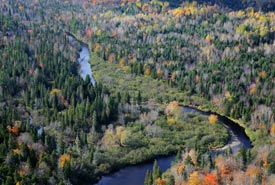Bartholomew River

Bartholomew River, Miramichi, NB (Photo by Mike Dembeck)
In 2016, thanks to a generous land donation, the Nature Conservancy of Canada (NCC) protected 850 hectares (2,100 acres) of ecologically significant habitat on the Bartholomew River — a tributary of the Southwest Miramichi River. The first land acquistion by NCC in the Miramichi Watershed, it was also the largest private land conservation project in New Brunswick's history.
The Foxner Nature Reserve was named for the former land owners, Brian and Carolyn Fox and Carl and Ann Faulkner, who donated the land through the Government of Canada's Ecological Gifts Program. The reserve includes old growth forest surrounding five kilometres of the Bartholomew River.
The Miramichi Watershed is world-renowned as the site of North America's largest run of Atlantic salmon, which occurs between mid-June and early October. The Bartholomew River is considered an important fish nursery within the watershed.
This conservation project added to the adjacent provincial Dungarvon Whooper Spring Woodlot Protected Natural Area and created a continuous wilderness corridor of more than 4,050 hectares (10,000 acres) between the Dungarvon and Bartholomew rivers.
Conservation values
The five kilometres of river encompassed by this project contain eight salmon pools. It also includes the only two cold-water holding pools along the entire river. These deep holding pools are important for regulating the temperature and health of the fish as they move upstream to spawn
The river is sheltered and shaded by the old-growth Wabanaki (Acadian) forest along the banks. Sugar maple, yellow birch, white pine and eastern white cedar are mixed with white ash, eastern hemlock trees and even a rare, pure stand of black ash. This wilderness area is also home to large mammals, like moose and black bear. These mammals need big, wild spaces to roam.
Natural wetlands on the property have been expanded by beavers. These wetlands provide breeding habitat for numerous waterfowl, such as black duck, teal and mallard. The forests, wetlands and riverbank contain excellent habitat for a variety of rare or at-risk species, including wood turtle, Canada warbler and olive-sided fly-catcher.
Funding for this project was provided by the Government of Canada, Province of New Brunswick (RDC), Honourable Frank McKenna, TransCanada Corporation, New Brunswick Wildlife Trust Fund, Echo Foundation, Mountain Eduipment Co-op and many other donors and supporters.




